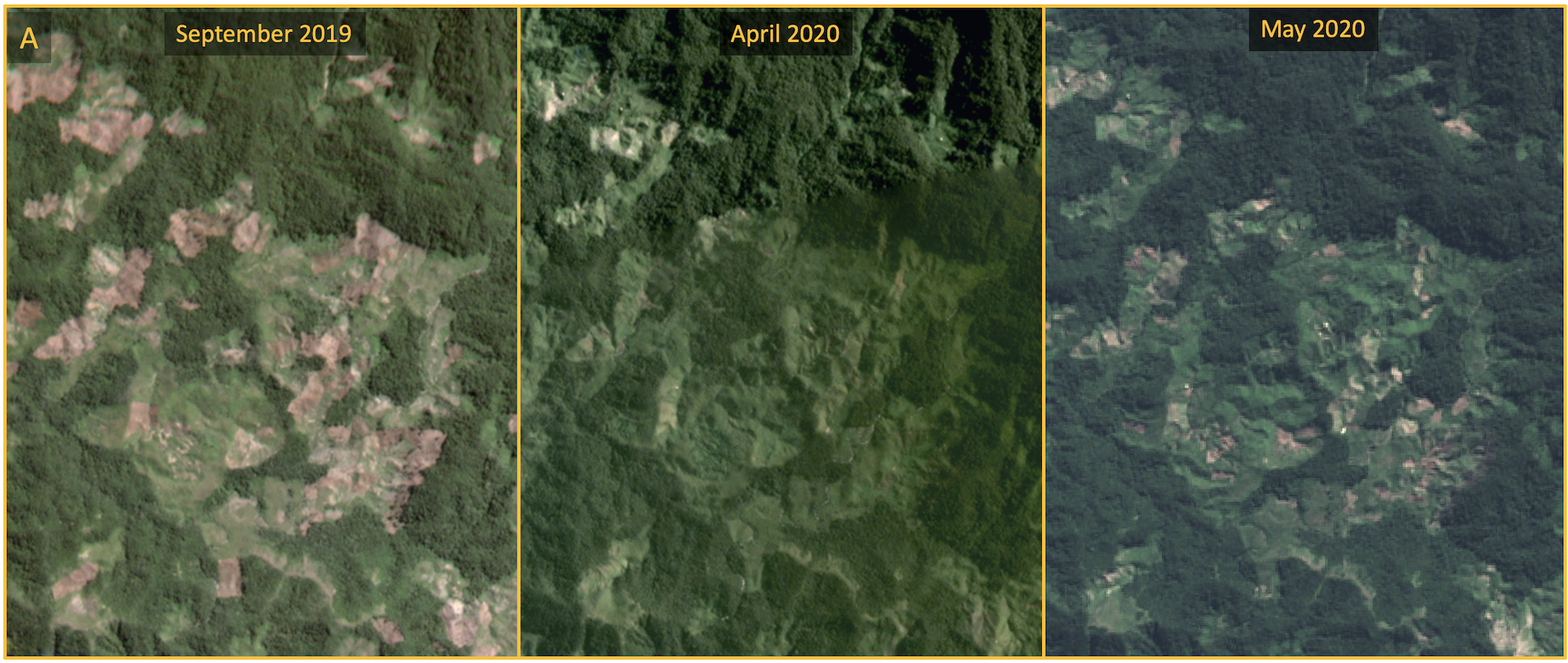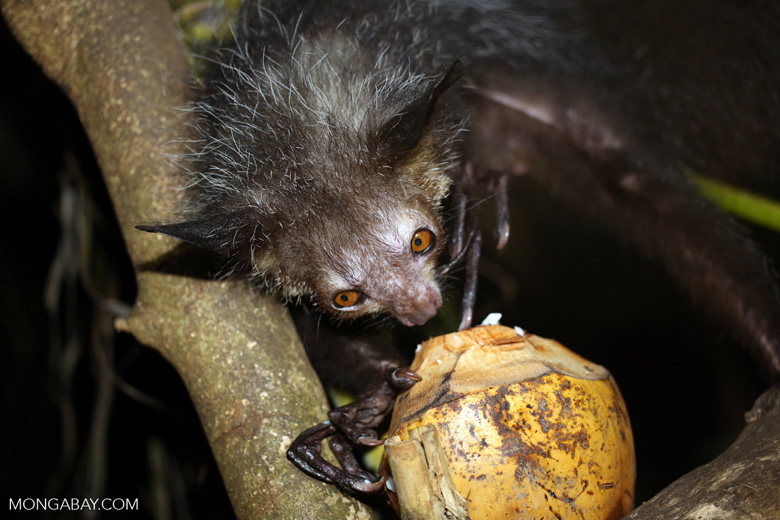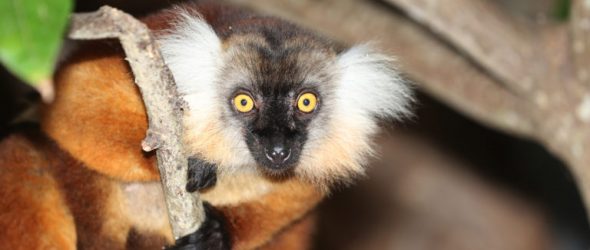- Northern Madagascar contains the largest block of connected forest left in the country.
- Tsaratanana Reserve is supposed to protect a large portion of this forest. However, satellite data and imagery show Tsaratanana is being cleared at a rapid rate.
- Local officials say slash-and-burn agriculture for marijuana cultivation is to blame. The Madagascar National Parks agency helped organize military deployments to the Tsaratanana area in 2014 and 2017, and is planning another intervention this year.
- Scientists say that if this deforestation continues, it will fragment the reserve’s well-connected forests and threaten the animals that live there — many of which are found nowhere else in the world.
Between the cacao fields of northwest Madagascar and the vanilla of the northeast, a chain of rainforests bob along the highland interior. Tsaratanana Reserve, home to the country’s highest peak, has long been a key link in the chain, with abundant primary forest mostly undisturbed by human activity. Yet the reserve now faces threats on an unprecedented scale.
Primary and secondary forest in Tsaratanana Reserve is being cleared at a rapid rate, according to satellite data from the University of Maryland visualized on Global Forest Watch (GFW). Local officials say slash-and-burn agriculture for marijuana cultivation is to blame. Scientists say that if this deforestation continues, it will fragment the reserve’s well-connected forests and threaten the animals that live there — many of which are endemic, which means they’re found nowhere else in the world.




The GFW images reveal a serious level of deforestation, according to scientists who have worked in the area, three of whom looked at the data at Mongabay’s request.
“The recent forest loss and environmental damage occurring in the Tsaratanana region is substantial, especially at lower elevations (<1000 m) [under 3,281 feet] and along rivers,” Christopher Raxworthy, a herpetologist at the American Museum of Natural History (AMNH), wrote in an email to Mongabay. “[C]ontinued clearing at this magnitude will severely damage the future conservation value of the Tsaratanana Reserve.”
‘A serious threat’
The satellite data indicates that the rate of “tree cover loss” increased from 2018 to 2019 and again early this year, even during the rainy season, which is not normally a peak time for clearing. Data for April indicates it may be accelerating further as the rainy season comes to an end. The geographic breadth of the forest losses is also expanding, with farmers apparently accessing more areas. Most of the deforestation appears to be in valleys, as higher areas would be more difficult to access, and are often too cold and wet to farm.
Much is at stake as the reserve loses tree cover, scientists say. Tsaratanana’s rich biodiversity includes at least eight species of lemur, at least half of which are already threatened. The reserve is also full of locally endemic plants and animals. For example, there are at least 25 amphibians and reptiles that have been found only in the reserve or the broader Tsaratanana region, herpetologists say. Many of those, such as two types of leaf-tailed geckos (Uroplatus spp.), have only recently been described in the literature. (There’s a time lag between on-site research and publication; relatively few scientists have worked in the reserve in the past decade.)

Raxworthy, the AMNH herpetologist, has taken 10 or so research trips to Tsaratanana over the last few decades. He says it’s difficult to determine the extinction risks that the deforestation poses to individual species, but there is cause for concern. In a well-known 2008 study published in Global Change Biology, Raxworthy showed that Tsaratanana’s reptiles and amphibians were moving upslope as their environment warmed due to climate change — some of the first scientific evidence that tropical animals were already moving to higher ground. The reserve’s topography — what Raxworthy referred to as “elevational diversity” — gives animals this freedom. But he warns they may not be able to continue moving if their habitat is fragmented.
“It could make it harder for them to shift their elevational range in response to global warming, which makes them even more vulnerable,” he said.
Environmental degradation is not entirely new to Tsaratanana. Colonial expeditions led to accidental and intentional fires on Maromokotro, the massif with the highest peak, in the early 20th century. In 1903, for example, a French geographer started fires for spectacle during three ascents to Maromokotro.
“Alas, that such a fool should not have been incinerated in one of his own fires!,” Joseph Marie Henry Alfred Perrier de la Bâthie, a well-known botanist who visited Tsaratanana in 1912, later wrote of the geographer.
Perrier de la Bathie’s work helped Tsaratanana become one of the first protected areas in Madagascar, and indeed the tropical world, in 1927. Since that time, the exact boundaries of the reserve have shifted, but its protection status has not: all activity aside from scientific research is still banned. (The reserve’s full name is Tsaratanana Strict Nature Reserve.) Still, foreigners and local people have long had an impact on the reserve’s ecosystems. Some of the lower areas on the outskirts or just outside the boundaries, especially to the northwest, toward the city of Ambanja, have been denuded for many decades.
Yet in a country that’s lost about half of its primary forest since the 1950s, Tsaratanana Reserve has been, until recently at least, in remarkably good shape, protected by its remoteness and its mountainous terrain. It takes three or four days walking from the nearest road to reach many parts of the interior. Scientists who’ve undertaken studies in the reserve in the last two decades — not a large club, given the logistical challenges — say that few cattle grazed there and there was little human activity. They say their teams had to open trails with machetes; several expeditions to Maromokotro, which is 2,876 meters (9,435 feet) high, failed to reach the peak. Those that did felt they’d reached a special world.
“You could imagine a hobbit coming around the corner,” Miguel Vences, a herpetologist at Technische Universität Braunschweig in Germany whose team reached the summit in 2010 after stopping at a lower elevation in 2001, told Mongabay. “It’s like an enchanted little forest, with mosses and so on.”

Vences said the new satellite data spells bad news for the forest. “Certainly, this extensive deforestation will be a serious threat to many of the endemic species in Tsaratanana and entire northern Madagascar,” he wrote in an email. He said he was not surprised to see that most of the clearing was in the north of park, given its proximity to coastal communities that rely more on shifting cultivation.
Malagasy officials say that people are clearing the reserve’s forest to grow marijuana.
“The main cause of land clearing in this Protected Area is the illicit exploitation of cannabis (marijuana),” Charles Andriamaniry, director of the reserve for Madagascar National Parks (MNP), the semi-public agency that manages it, told Mongabay in an email. “It is a very isolated area which allows drug traffickers to protect themselves.”
The problem is longstanding, dating back to 1960, and enforcement is very difficult, officials say.
“We have already worked with the military to clear out cannabis planters, but this phenomenon recurs almost every year,” Mamy Rakotoarijaona, MNP’s director general, wrote in an email to Mongabay.
“ONE NEEDS TO FIND A LONG-TERM SOLUTION TO THE PLANTATION OF CANNABIS,” Luciano Razafimahefa, a spokesperson for the environment ministry, told Mongabay in an email, putting the sentence in all capitals for emphasis. The marijuana is produced for export and all the activity is “underground,” Razafimahefa said.
Local news articles indicate that Malagasy marijuana is exported primarily to neighboring island countries in the western Indian Ocean; some is also consumed domestically. All production and possession is illegal, regardless of whether one is growing it in a protected area.
Taking action
Madagascar National Parks helped organize military deployments to the Tsaratanana area in 2014 and 2017. In two 2017 interventions, the brigade found 30 cannabis storehouses and many tons of marijuana in various forms within the reserve’s boundaries, and burned or otherwise destroyed all of it. The officers also arrested 12 cannabis operators including two that were carrying firearms. A local court sentenced each of them to between three months and two years in prison, according to MNP.
Another such operation has already been planned for this year. Four soldiers from the military, two armed police officers called gendarmes, and two agents from MNP will go into the parts of the reserve under the most “pressure” from farmers. They plan to destroy any cannabis they find and arrest those involved. They will take the cases to the local prosecutor in Ambanja, and courts there will determine fines and penalties, MNP representatives said.

The pursuit of the growers is not easy, as the military brigades travel on foot and move through the forest slowly; oftentimes, farmers and traffickers have fled before they arrive, MNP representatives said.
Although most of the clearing is in the north of the reserve, and some operators and farmers may be accessing it from the northwest, many of them come from far-flung places in the Sofia region south of the reserve, or even from the far south of Madagascar, according to MNP.
The problem is not a matter of lack of alternatives in areas near the reserve, MNP representatives said. Areas in the vicinity are suitable for growing valuable cash crops such as pepper, cacao, vanilla, and plants for essential oils. But marijuana is easier to grow several times per year and requires little maintenance, a key crop attribute in such a remote area. It also fetches exceptionally high prices, MNP representatives said.
Researchers say that if Tsaratanana can’t be more effectively protected, the impact of its deforestation will likely be felt in ecosystems throughout the northern highlands.
“This was the largest block of forest left in Madagascar,” Brian Fisher, an entomologist at the California Academy of Sciences who has worked in the region, told Mongabay. “Each of mountains was connected, almost from Marojejy to Manongarivo. Now it could be end up being isolated fragments all above [a certain altitude].
“The story could be that we’re losing the largest block of connected forest in Madagascar.”
Banner image of a black lemur (Eulemur macaco) by Rhett A. Butler/Mongabay.
Editor’s note: This story was powered by Places to Watch, a Global Forest Watch (GFW) initiative designed to quickly identify concerning forest loss around the world and catalyze further investigation of these areas. Places to Watch draws on a combination of near-real-time satellite data, automated algorithms and field intelligence to identify new areas on a monthly basis. In partnership with Mongabay, GFW is supporting data-driven journalism by providing data and maps generated by Places to Watch. Mongabay maintains complete editorial independence over the stories reported using this data.
Feedback: Use this form to send a message to the editor of this post. If you want to post a public comment, you can do that at the bottom of the page.


